Pilot Paul Rask kissed the snow with his skis a couple times to test the surface, then set us down smoothly on the Murray Ice Cap. Here, within  spectacular Ellesmere Island National Park, we will be conducting climate research for the next 3 years. After quickly unloading 2000 pounds of gear Twin Otter C-GASS roared back into the sky, and the Arctic silence engulfed us. The elevation of the Ice Cap is 1100m, at 81°21.4' N and 69°14.5' W, providing views of the Hazen Plateau and the United States range to the north, Greenland to the east, and south to the mountains of Judge Daly Promontory.
spectacular Ellesmere Island National Park, we will be conducting climate research for the next 3 years. After quickly unloading 2000 pounds of gear Twin Otter C-GASS roared back into the sky, and the Arctic silence engulfed us. The elevation of the Ice Cap is 1100m, at 81°21.4' N and 69°14.5' W, providing views of the Hazen Plateau and the United States range to the north, Greenland to the east, and south to the mountains of Judge Daly Promontory.  On our arrival the afternoon of May 25th we were thrilled to see that snowmelt had definitely not yet begun -- the snowpack basal temperature was still about -16°C.
On our arrival the afternoon of May 25th we were thrilled to see that snowmelt had definitely not yet begun -- the snowpack basal temperature was still about -16°C.
The first task facing us was deciding where to establish camp. Equipped with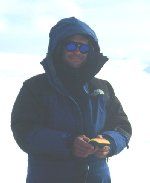 a map, airphotos and a GPS receiver, we sought a level campsite off the Ice Cap (for protection from the wind), with easy access to drinking water once the seasonal snowcover melted. We settled for a not-so-level site near
a map, airphotos and a GPS receiver, we sought a level campsite off the Ice Cap (for protection from the wind), with easy access to drinking water once the seasonal snowcover melted. We settled for a not-so-level site near 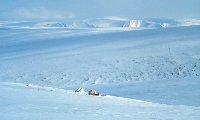 the ice cap margin within easy walking distance of the 'summit'. Our camp consists of three tents: one called an 'Igloo' in which we cook, eat, and do lab and office-type work, and two 'Mt. Logans' for sleeping. Within the Igloo is an HF radio with which we communicate with aircraft and the base operation of the Polar Continental Shelf Project -- our excellent logistical supporter.
the ice cap margin within easy walking distance of the 'summit'. Our camp consists of three tents: one called an 'Igloo' in which we cook, eat, and do lab and office-type work, and two 'Mt. Logans' for sleeping. Within the Igloo is an HF radio with which we communicate with aircraft and the base operation of the Polar Continental Shelf Project -- our excellent logistical supporter.
Among our first scientific tasks was measuring and characterizing the snowpack. On the Murray Ice Cap, which is the primary focus of our investigation, we found only seasonal snow overlying hard ice. The average accumulation was remarkably consistent at 39 cm (std. dev. = 5.3), and varied in density between 50 and 340 kg/m3 (newest and previous fall, resp.).
Working conditions were relatively comfortable during the first 5 or 6 days (-20° to -8°C with light wind), so we tried to get the weather stations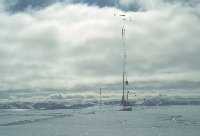 operating as quickly as possible. At the 'summit' of the Murray Ice Cap we erected a 10 m tower supporting an array of sensors to be operated seasonally. These include wind speed,
operating as quickly as possible. At the 'summit' of the Murray Ice Cap we erected a 10 m tower supporting an array of sensors to be operated seasonally. These include wind speed, 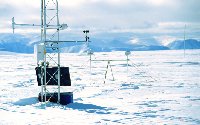 temperature and humidity at two heights (aspirated), along with incoming solar and atmospheric radiation (both ventilated continuously). Solar panels provide 50 watts of power (peak) to run all the fans, backed up by 200 amp-hours of batterys.
temperature and humidity at two heights (aspirated), along with incoming solar and atmospheric radiation (both ventilated continuously). Solar panels provide 50 watts of power (peak) to run all the fans, backed up by 200 amp-hours of batterys.
Within 50 m of the tower is another station which will operate year-round. Listed from top to bottom on the image below, sensors on this tripod currently 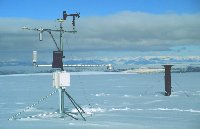 measure wind speed & direction, atmospheric radiation, incoming and reflected solar radiation, snow accumulation/ablation,
measure wind speed & direction, atmospheric radiation, incoming and reflected solar radiation, snow accumulation/ablation, 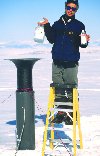 temperature and humidity, terrestrial radiation, and barometric pressure. A nipher-shielded precipitation gage is also connected to the datalogger, which is shown being charged with 'environmentally friendly' antifreeze (and Baby Oil).
temperature and humidity, terrestrial radiation, and barometric pressure. A nipher-shielded precipitation gage is also connected to the datalogger, which is shown being charged with 'environmentally friendly' antifreeze (and Baby Oil).
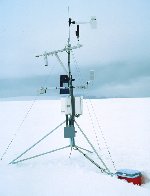 On the tundra between the Murray and Simmonds Ice Caps, another year-round station was installed which is only slightly less comprehensive than the 3m station on the Murray. The underlying surface is not really tundra, but rather felsenmeer which in some years may not be snow-free until late July. To reduce the likelihood of damage by animals, all the lower cabling at this station was run through bite-proof conduit. The Tundra Station is located 2 km to the south of camp (see airphoto).
On the tundra between the Murray and Simmonds Ice Caps, another year-round station was installed which is only slightly less comprehensive than the 3m station on the Murray. The underlying surface is not really tundra, but rather felsenmeer which in some years may not be snow-free until late July. To reduce the likelihood of damage by animals, all the lower cabling at this station was run through bite-proof conduit. The Tundra Station is located 2 km to the south of camp (see airphoto).
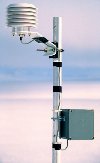 To complement the three complete weather stations, we installed an array of 10 temperature measurement stations. The array covers approximately 150 km2 on the plateau, and will provide information about how the ice caps (and snowcover) influence the spatial pattern of air temperature. Sensors have been sited adjacent to stations G10 (Ice Cap) and T3 (tundra) to establish relationships between (i.e. intercompare) the different probes and shields.
To complement the three complete weather stations, we installed an array of 10 temperature measurement stations. The array covers approximately 150 km2 on the plateau, and will provide information about how the ice caps (and snowcover) influence the spatial pattern of air temperature. Sensors have been sited adjacent to stations G10 (Ice Cap) and T3 (tundra) to establish relationships between (i.e. intercompare) the different probes and shields.
Even during the summer, weather conditions on the Hazen Plateau create difficulties for meteorological measurements. These images from 6 June 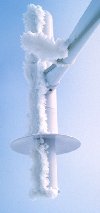
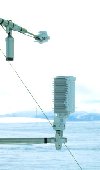 illustrate riming on two of the temperature/humidity probe radiation shields, and on the G3 albedometer. Initial data from this time period demonstrate that humidity measurements in the non-aspirated shield (left image) were indeed biased upward due to airflow through the rime. Comparing the ventilated solar radiation measurements with those made by this sensor demonstrates that the latter are also unreliable -- as might be expected! This year the field team is maintaining frequent inspection of the sensors during riming conditions, and development is underway for automated acquisition of images at the station for quality control.
illustrate riming on two of the temperature/humidity probe radiation shields, and on the G3 albedometer. Initial data from this time period demonstrate that humidity measurements in the non-aspirated shield (left image) were indeed biased upward due to airflow through the rime. Comparing the ventilated solar radiation measurements with those made by this sensor demonstrates that the latter are also unreliable -- as might be expected! This year the field team is maintaining frequent inspection of the sensors during riming conditions, and development is underway for automated acquisition of images at the station for quality control.
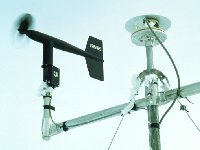 To reduce the influence of rime and precipitation on measurements, this project is experimenting with several new (for the High Arctic) pieces of equipment. Our Wind Sensor from R.M. Young is made from a black, hydrophobic material which to date has performed well.
To reduce the influence of rime and precipitation on measurements, this project is experimenting with several new (for the High Arctic) pieces of equipment. Our Wind Sensor from R.M. Young is made from a black, hydrophobic material which to date has performed well.
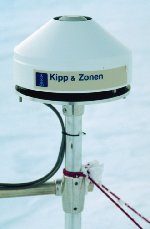 We are also having great success with ventilation of several seasonally-deployed radiometers, despite the high current consumption required (420 mA continuous). We have a provision for heating these as well, but this has not been necessary due to the effectiveness of the ventilation. Twenty-four hours of solar radiation helps to minimize the diurnal temperature fluctuation (reducing condensation/deposition), and to keep the batteries charged!
We are also having great success with ventilation of several seasonally-deployed radiometers, despite the high current consumption required (420 mA continuous). We have a provision for heating these as well, but this has not been necessary due to the effectiveness of the ventilation. Twenty-four hours of solar radiation helps to minimize the diurnal temperature fluctuation (reducing condensation/deposition), and to keep the batteries charged!
Currently in the field, drilling in ablation stakes, watching the snow melt, shining the radiometer domes, using aerial photography from kites to map snowcover, and otherwise maintaining the field program until mid-August, are Carsten Braun and Bianca Perren!
![]()
 spectacular Ellesmere Island National Park, we will be conducting climate research for the next 3 years. After quickly unloading 2000 pounds of gear Twin Otter C-GASS roared back into the sky, and the Arctic silence engulfed us. The elevation of the Ice Cap is 1100m, at 81°21.4' N and 69°14.5' W, providing views of the Hazen Plateau and the United States range to the north, Greenland to the east, and south to the mountains of Judge Daly Promontory.
spectacular Ellesmere Island National Park, we will be conducting climate research for the next 3 years. After quickly unloading 2000 pounds of gear Twin Otter C-GASS roared back into the sky, and the Arctic silence engulfed us. The elevation of the Ice Cap is 1100m, at 81°21.4' N and 69°14.5' W, providing views of the Hazen Plateau and the United States range to the north, Greenland to the east, and south to the mountains of Judge Daly Promontory.  On our arrival the afternoon of May 25th we were thrilled to see that snowmelt had definitely not yet begun -- the snowpack basal temperature was still about -16°C.
On our arrival the afternoon of May 25th we were thrilled to see that snowmelt had definitely not yet begun -- the snowpack basal temperature was still about -16°C.